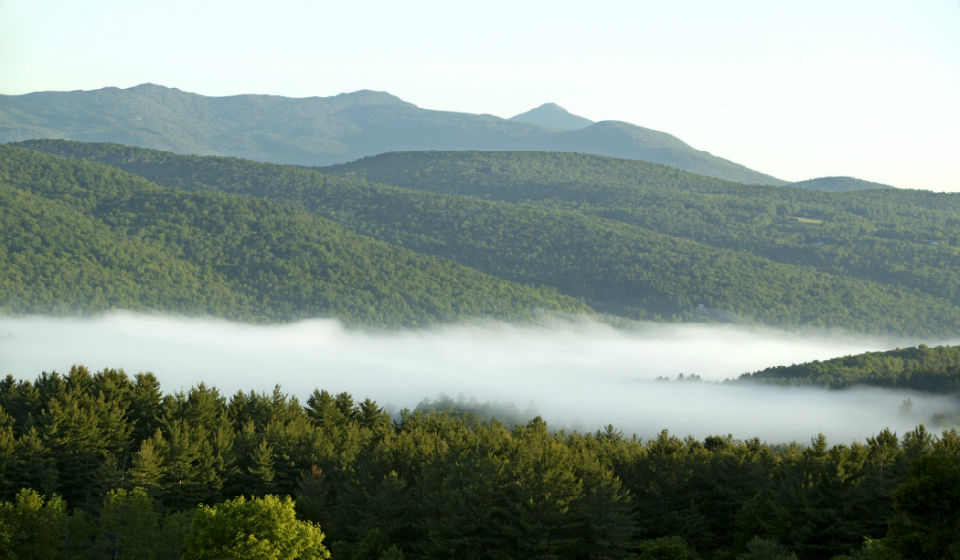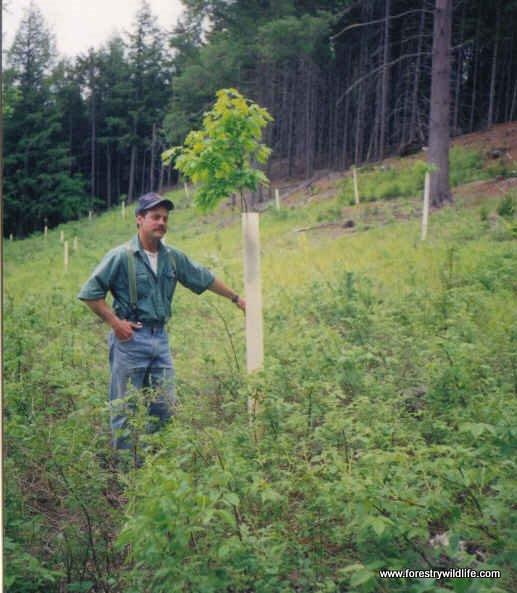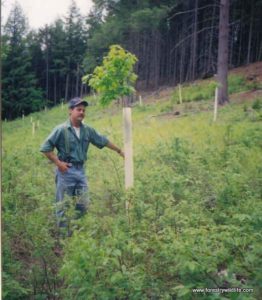Establishing Red Oak
Author:Patrick Bartlett | Organization:Consulting ForesterPatrick Bartlett || Consulting Forester
ESTABLISHING RED OAK TREES ON YOUR PROPERTY
By Patrick Bartlett, Forestry & Wildlife Habitat Consultant
Getting red oak regeneration to survive and become a tree is frustrating to say the least, foresters and wildlife managers know this all too well. I have been planting red oaks for 30 years and would like to share some of my trials, errors and successes. If you learn from my mistakes, you should have a 90% success rate in growing oaks.
Collecting acorns and throwing them around on a hillside is a waste of time. These nuts have an aroma that gives them away to the animals that cherish them; most will be eaten in days. Planting a germinated acorn in April or May will reduce the chance of it being eaten before becoming a seedling. The best way I have found for germinating acorns is to collect acorns in the fall of the year, and place them in a bucket of water after collecting them. Fertile acorns will sink, throw the floaters away. If you only doing a few dozen, place the good acorns in a sealable plastic gallon bag and put a very wet paper towel over them. I store mine in a one gallon, clear, zip-lock baggy with a wet paper towel. I keep it in the vegetable drawer in the refrigerator. If you are doing large amounts of acorns, use an old seed or grain bag, burying them in the this bag in your garden 12” deep. If you keep them in your refrigerator, 3 times during the winter the paper towel should be moistened again. If you are not seeing condensation on the inside of the bag then itʼs too dry. The key is to keep them from freezing or drying out. When the middle of April approaches, take the bag out of the refrigerator or garden. The roots should be starting to emerge. Be sure to store them in cool, moist place before planting them. They should be planted before the root gets to be 1/2 inch long.
I have had very good and cost effective results planting these germinated acorns in poplar, white birch, red spruce or pine patch cuts with logging slash on the ground. The first spring after the cut has been done is the best time to plant. Best time is just after the snow melts off the ground in April. When Iʼm planting sprouted acorns, I just poke a hole in the ground one inch down, place it in with the cap side or flat top pointed down, then cover it over. The less you disturb the ground, the better. Squirrels will rob your sprouted acorn if they find it. I like to plant them under tops that have been left after a timber sale or in the center of a group of spruce seedlings. Spruce tops take years to rot and will protect the oak seedling. Leaving tops whole is recommended to impede the deer movement. Planting acorns with a group of spruce seedlings that are six to twelve inches tall is like having a live, natural barrier from the deer. Avoid panting the acorns where there is established hardwood regeneration.
If you want to go one step further in regenerating oaks trees, it would be to provide a man- made shelter for the vulnerable oak seedlings. Obviously this is a more expensive approach but is worth it if you have a deer browse problem on your property. An annual spring checkup for at least six years is recommended so planting where there is easy access is also highly recommended. Bears will often disturb the tubes in the woods. I would only use the tubes in meadows or near houses where bears do not travel.
A company called Treessentials (1-800-248-8239) makes a biodegradable brown plastic tube that is placed over the seedling. I have planted approximately 500 oak seedlings in these tubes over the past twenty years, which I have had good results with. The five foot tube is the one to use for deer protection. It is critical to sink the tube at least one inch into the ground around the seedlings so that mice will not nest in it and girdle your seedlings. The tube has one vase shaped end which should be pointed upward. After the tree emerges, this tapered edge does less damage to the tender bark if the tree gets blown around in the tube.
It also helps hold the netting on. In areas where deer use is heavy in the winter, this will not be high enough once your seedling emerges from the tube. In this case, I slide the tube up the stake as the tree grows. The tubes come with two plastic quick ties for attaching to a stake. They also come with a netting that slides over the top of the tube. This is to prevent birds from becoming trapped in them and the new, finer netting design keeps wasps out of the tube. Sink the tube 1” into the soft soil to prevent mice from using the tube as a nesting site and girdling the seedling. The netting must be removed the year that you expect the tree to reach the top of the tube. I like to remove the netting when the tree is within 16” from the top of the tube in the spring of the year.
Wooden stakes can be bought with the tubes, however, I have recently started using 5/16 inch rebar instead. This rebar can be bought at some lumber yards. I can use these stakes repeatedly in my forestry business and in doing so it reduces costs for my clients. I cut a twenty foot section into three pieces. This stake wonʼt rot and will be long enough so that you can slide the tube up if you need to. I like to leave the tube on until the trunk of the oak is one inch in diameter. You will have to cut the tube to get it off the tree which I prefer to do in the spring. This gives the bark a chance to harden up and is not so tempting to mice or rabbits in the winter. Any sucker sprouts should be pruned off at this time. The saplings may be weak and should be loosely tied the stake with something that will not damage the bark. I prefer to use stove pipe wire slid inside of old sugaring tubing that has been discarded. Most sugar makers have some lying around.
Two year old container stock seedlings (not bare root) are recommended when buying oaks from a nursery. I have had good success with Musser Nursery stock – (800)643-8319. They should only be planted in the spring or fall when the moisture in the soil is high. The trees will generally grow twelve to sixteen inches a year in the tubes. I recommend putting a tablet or tea bag of slow release fertilizer one inch down in the soil above the roots of the seedling.
Loose granular fertilizer may be a lot cheaper but I have had porcupines smell the loose granular fertilizer. They have a craving to eat it and have dug the seedlings out of the ground to get at it. I have never had this happen with the fertilizer tablets. It is very helpful to pull in some leaf mulch and build it up around the seedling to help hold the moisture in the soil. I have had a 90% survival rate so far with the oaks planted in these tubes where bears did not frequent and chew up the tubes.
Oaks love the sun, so it is important to plant them where they will get plenty of sunlight. If you are planting a small patch cut, plant in the center or the North side but not under the canopy of edge trees. Patch cut should be no less than a 1/2 acre in size and 1 acre is recommended.
This may seem like many work but after you do a few the planting time should be two minutes per tree with annual maintenance being around one minute per tree. There is often cost share programs to help cover some the costs. Check with your County Forester, Extension Forester or Wild Turkey Federation to see if there is cost share money. I generally have extra sprouted acorns every spring if you wanted to go with that method.
I like to remind my clients that one good log from a timber harvest can pay for a small oak plantation. I encourage the landowners and children to help with planting these trees and they all seem to get a great deal of satisfaction putting a little something back into their woodlot instead of their bank account.
Critics have stated that this is not cost effective forest management, however, I do not plant a dozen oaks on one hundred acres for harvesting. The plan is to grow a few seed trees that
someday will provide food for wildlife, but what is more important, a seed source that will be produce acorns for decades to come, that will be spread around by the wildlife that feeds on them.
You can see pictures of this whole process on my web site.
Patrick Bartlett
Forester, Wildlife Consultant and Guide Bartlett Forestry & Wildlife LLC.




